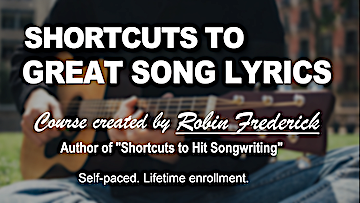
Today, poetry is often defined as putting the greatest amount of meaning into the fewest possible words. This holds true for song lyrics, too. So if you’re a poet, you’ve got a great start on songwriting. But there are some big differences, too.
The bards of old sang their poems, often based on historical tales. The melody helped both the bard and the audience remember long oral histories. But now we tend to write and read poetry on the page. Readers can go through a poem at their own pace, taking all the time they need to understand and react to each line.
But songs roll by at the music’s pace. Listeners need to understand enough on the fly to be drawn into the lyric and stay involved. To turn a poem into a lyric, you’ll need to take that into account.
1. Give listeners enough time to absorb an image or poetic device.
Try spreading out your images and metaphors over several lines rather than piling on several at once. Make each image or idea the focus of at least one line. If your lines are short, then spend two or more lines on it. Add more information to give listeners deeper insight into your idea and allow them to fully take it in before moving on.
2. Mix poetic expressions with simple, direct language.
A mix of poetic devices and clear, conversational language is ideal for songs. If listeners have to stop and think about what a line means, you could lose them. While they’re thinking about the line, the song has moved on and you won’t get them back. Give listeners enough direct statements to keep your ideas clear and in focus.
Read You and Your Listener: It’s a Relationship to learn more about staying in touch with your listener while writing.
3. Use a conversational tone.
While you write, keep the emphasis on saying what you want to say. Before you worry about rhyming, meter, or line length, express your thoughts and emotions just as you would speak them. When you twist a line out of shape to accommodate a rhyme or meter, your lyric loses believability. Today’s song lyrics sound authentic and natural – as if the singer just thought of them, so it’s essential that you preserve the natural flow of speech.
Learn more about how rhymes are used in today’s song lyrics.
4. Speak your lines out loud as you work.
Make sure there are no difficult combinations of letters that will be hard to sing. Also, lines that look fine on the page may be misunderstood when a singer delivers them. Jimi Hendrix’s “Excuse me while I kiss the sky” is easily misheard as “Excuse me while I kiss this guy.” While there are plenty of hit songs with famously misheard lyric lines, you’ll be better off if you avoid that problem.
5. Use a song structure.
Song structures are different from the today’s poetry structures. Contemporary mainstream songs rely on a pattern of repeated sections like this one:
VERSE 1 / PRE-CHORUS 1 / CHORUS
VERSE 2 / PRE-CHORUS 2 / CHORUS
BRIDGE / CHORUS
A strong, repeated chorus section is a must-have. The mix of repeated sections and new material keeps listeners involved in the song as it moves forward. Too much repetition and they get bored. Too much variety and they get lost.
Find out how to use song structure to connect with listeners.
Write your poem to a melody
To turn a poem into a lyric, you need to make sure it will work with a melody. Too often, when we write lyrics on the page instead of to a melody, they come out sounding like predictable nursery rhymes or greeting cards. You want to get as far away from that as you can! Here’s how…
- Choose a successful song you like.
- Learn to sing the melody.
- Write your own lyric to the melody. Aim for lines that fit comfortably—you don’t have to match the original syllable for syllable. Adapt the melody as needed.
- If you’re working with a collaborator who will be writing the melody and chords for your lyric, don’t tell them the name of the song you used as a basis for your lyric. Let them work out a new melody based solely on what you wrote. Here’s more info on finding and working with co-writers.
IMPORTANT: Be sure you don’t use any of the existing song’s lyric. It’s protected by copyright.
May your songs flow!
Robin
